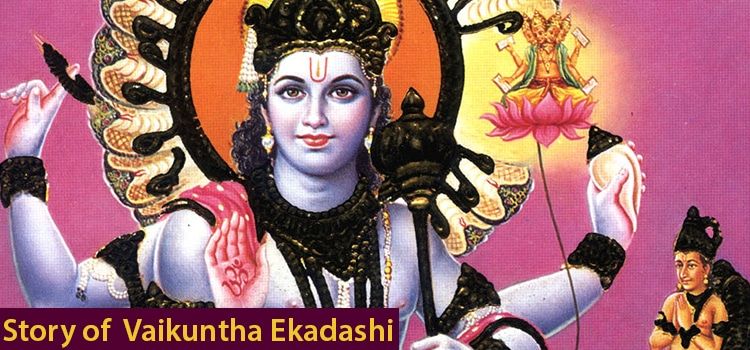Ekadashi and the killing of the demon Mura
The Padma Purana says that during the Krita (Satya) Yuga, a powerful demon called Mura obtained great powers by performing severe penance. Armed with his powers, he defeated the gods who ran to Lord Shiva for help. He said that only Lord Vishnu could solve their problem. So Vishnu waged a battle against Mura. The epic battle went on for one thousand celestial years. At one point, Vishnu wanted to take rest for a while. He had also realized that Mura could not be destroyed by the usual weapons. He needed a different weapon, one against which Mura’s powers would be ineffective. Vishnu then entered a beautiful cave called Himavati in Badarikashrama to take rest and create a new weapon. Mura planned to attack Vishnu while he was fast asleep. But Vishnu’s Shakti or female energy came out of his body in the form of a beautiful woman. She fought Mura and burnt him to ashes with one look.
Ekadasi’s boon
When Vishnu woke up and realized what had happened, he was very pleased. He gave the name Ekadasi to the maiden and gave her a boon. The maiden made a request to him. She wanted him to give her the power to deliver people from their sins if they observed a fast on this day. Vishnu gave her the boon and announced that those who worshipped Ekadasi would reach his abode, Vaikuntha. In this manner, the first Ekadasi was born.
Margashirsha month
One earthly year is equivalent to one day in heaven or Deva loka. The earthly year has two parts based on the Sun’s transit. The Sun’s northerly transit is Uttarayan, which corresponds to the months from January to June (Hindu months, Margashirsha masa to Ashada masa). The Sun’s southern transit is Dakshinayana which corresponds to the months from June to December. For the heavenly beings, Uttarayana represents day, and Dakshinayana represents night. The month of Margashirsha usually falls in the last month of Dakshinayana is regarded as the pre-dawn. The 11th day of the lunar month (Ekadasi) is when dawn begins. Hence it is auspicious for worshipping Vishnu, as He appears to the residents of heaven and gives them his blessings.
How is Vaikunta Ekadasi Celebrated?
According to legend, the gates of Vaikunta open on Vaikuntha Ekadashi day. A ‘Vaikunta Dwaram’ or ‘gateway to heaven‘ is erected in the temple, and devotees enter the temple through this, symbolizing their entry to Vaikunta. In all Vishnu temples, the northern door will be open on this day, and devotees visit the Lord through this door.
Fasting is an important ritual of Vaikunta Ekadasi as it supposedly helps to eradicate sins and attain Moksha. It is said that those who observe fast on this day will go to Heaven. People avoid grains like rice and non-vegetarian food. Some do not take even onion and garlic. Rice is not taken as the belief is that the demon Muran dwells in the rice. Milk and milk-based products as well as fruits can be consumed. Some do not take even water on this day. It is believed that Vaikunta Ekadasi fast pleases Vishnu greatly, and he bestows many boons on those who observe the fast. Food is eaten only once. In the evening, fruits, flowers, Naivedya, vermilion, and turmeric are offered to Vishnu.
On the day after, which is Dwadasi, people take Tulasi water and break the fast. Breaking the fast is called Paranai. After the fast, people take simple food like a raita made with urad dal or Black Gram, and Agathi keerai, a type of greens, or Gooseberries in curd. Devotees also chant Vishnu Mantras like Vishnu Sahasranamam on this day or read the Bhagvad-Gita. Some donate food to Brahmins.
Vaikunta Ekadasi festival is celebrated grandly by Vaishnavites. Vishnu temples in Tamil Nadu, Kerala, Andhra Pradesh, and Karnataka celebrate it with great fervor. The celebrations at Tirumala Venkateswara Temple, Tirupati, Sri Ranganathaswamy Temple, Srirangam, and Trivandrum Padmanabha Swamy temple, are very famous.









Comments & Discussion
8 COMMENTS
Please login to read members' comments and participate in the discussion.